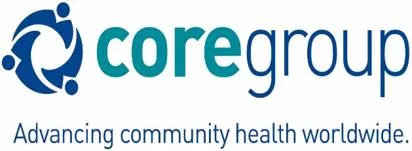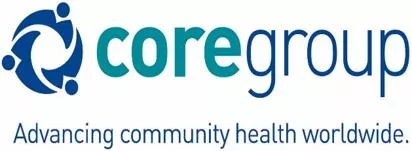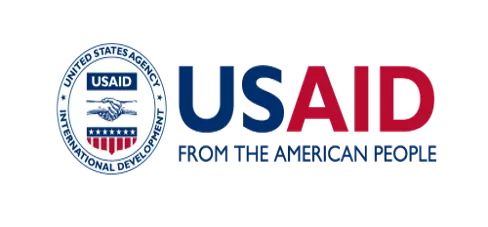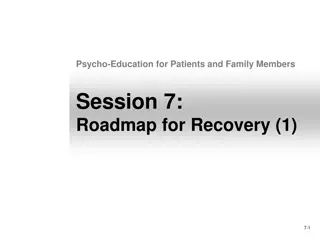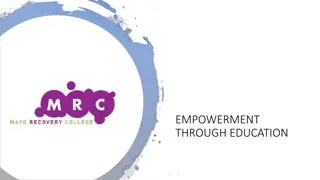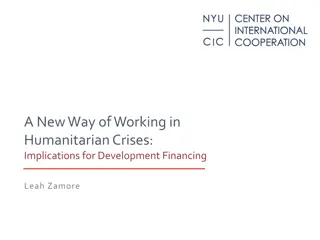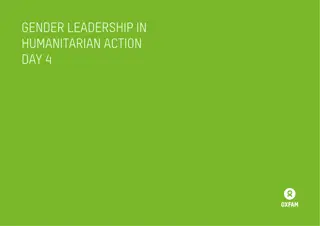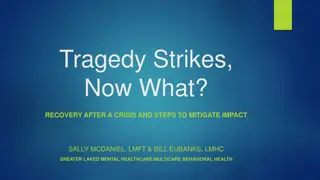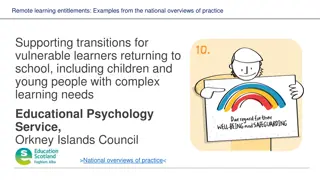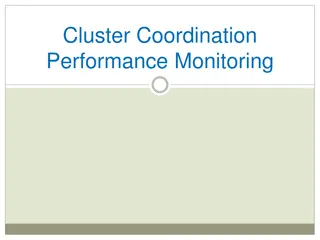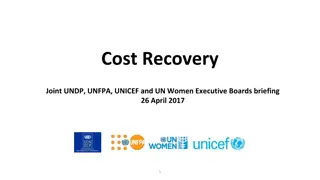Strengthening Health Systems in Protracted Crises and Transition to Recovery
Thematic brief discusses the importance of integrating health systems in humanitarian and development efforts to address challenges in transitional periods. Case studies from Pakistan and Sudan provide insights on improving health system strengthening to enhance capacity and resilience. Opportunities and gaps in Emergency Health and Nutrition programs are shared to inform better responses to emergencies.
Download Presentation

Please find below an Image/Link to download the presentation.
The content on the website is provided AS IS for your information and personal use only. It may not be sold, licensed, or shared on other websites without obtaining consent from the author. Download presentation by click this link. If you encounter any issues during the download, it is possible that the publisher has removed the file from their server.
E N D
Presentation Transcript
Increase Global Capacity for Coordinating, Integrating, and Transitioning Community Health and Nutrition in Response to Protracted Crises and in Transition to Recovery December 10, 2019draft dating Session
Thematic Brief: Strengthening Health Systems in the Humanitarian-Development Nexus Presenters: Justine Kavle, PhD, MPH Consultant, Kavle Consulting LLC Professorial Lecturer, GWU Milken School of Public Health, Global Hlth & PCH w/ Eric Sarriot, MD, PhD, Sr. Health Systems Advisor, Save the Children, USA December 10, 2019 dating Session
Strengthening Health Systems: Nexus Background ~ 132 million people need humanitarian assistance 1 of every 4 children affected by conflict/disaster Important, systemic changes can be made in international assistance efforts to meet and lessen the need for aid while also complementing local development efforts" Consistent challenges in transitional periods between humanitarian relief and development can undermine local stability & burden systems capacity.
Strengthening Health Systems: Nexus Objectives Recommend opportunities for improving health systems strengthening (HSS) in EHN programs Share gaps and lessons learned to inform on how to improve the strengthening of systems for health- capacity, sustainability, and resilience - while responsive to immediate needs in emergencies
Save the Children with University of Iowa: Case Study 1 & 2 Methods Systematic, embedded case study design was used to examine the systems effects of two EHN programs in Pakistan and Sudan from 2011-2018 Selection criteria for countries: ability to retrieve documentation, availability of key informants and experience to provide key lessons learned Conducted (1) theory development, (2) case selection, (3) data collection and analysis by case, (4) case report writing, (5) country case review and (6) key informant interviews, (7) cross-country analysis Codebook & qualitative analyses
Strengthening Health Systems: Nexus Sudan and Pakistan Country Profiles Pakistan Sudan* Ranked 5th highest on the world fragility index, constant state of crisis post-independence from South Sudan Known has 4th largest population of IDPs due to conflict, forced migration and natural disaster (floods) Received funds to integrate and scale up family planning (FP) and post-abortion care (PAC) into the package of essential health services its EHN programs in 13 health facilities in three districts across two provinces. Used community-based strategies to build capacity of health system across Health; Nutrition; Water, Sanitation, & Hygiene (WASH); and Child Protection (CP) sectors * Subsequent slides on key findings from Sudan only, brief describes both countries
Strengthening Health Systems: Nexus Key findings - Sudan Direct health and health services HSS element (+) Central focus on increasing accessibility of quality health care services to internally displaced populations (IDPs) and host communities, inclusive of infrastructure, human resources, management and technical support, health facility commodities, nutrition centers and mobile outreach services (+) Designed to hand over health facilities and activities to the MOH or local community- based organizations
Strengthening Health Systems: Nexus Key findings - Sudan National Coordination and Policy Setting (+) Government coordination with humanitarian partners ultimately enabled and supported the implementation of health interventions (+) Fostered MOH ownership through strong relationships and close coordination of activities, all signs of commitment to national policies to deliver an essential package of health services.
Strengthening Health Systems: Nexus Key findings Sudan Decentralization and Management Capacity HSS element (+) Expanded essential primary care services in geographical areas where no services existed/ services very weak and these service delivery sites were eventually handed over to the MOH, as Save the Children progressively transitioned out of these areas. (-) Changes in the MOH s use of processes for program learning at decentralized levels, and program management course correction were not formal objectives of the projects and were not formally documented
Strengthening Health Systems: Nexus Key findings - Sudan Engagement w/Community Organizations & societal partnerships HSS element (+) Strengthened community as a partner /asset to MOH through gains in service delivery and community utilization of service. (+) This included engagement with the formal health system through community health committees, community level monitoring, and referrals by volunteers and CHWs
Strengthening Health Systems: Nexus Key findings Sudan Costing and financing HSS element (+) Induced some local financing for health staff and clinics for handover to MOH (+) Contributed to the federal government s allocation to states health budgets and community-owned financing initiatives (-) Projects not designed to address large scale sustainable financing for health services in project areas
Strengthening Health Systems: Nexus Key findings Sudan Human Resources HSS element (+) Proxy measures indicated expanded human resources contributed to task shifting (i.e. service delivery rates achieved reflect MOH s expansion of presence and performance of healthcare providers and saw strengthened linkages between MOH staff and community resource staff (i.e. CHWs, village midwives etc.) for health promotion, monitoring, surveillance and referrals (-) No direct measures to gauge human resource contributions in program areas. National level contributions towards strengthening human resources and task shifting beyond program areas were not documented.
Strengthening Health Systems: Nexus Key findings Sudan Supply Chain Management HSS element (+) Implementing partner operated its own supply chain management in coordination with partners and donors, as the MOH did not have a supply chain management system respond to service delivery needs. (-) No indication that health system s ability to manage procurement and supply of commodities was strengthened
Strengthening Health Systems: Nexus Key findings Sudan Data: Health Information Systems, Monitoring & Evaluation - HSS element (+) Implementing partner contributed to CMAM database and the WHO Early Warning System for disease surveillance. (+) While not formally collected, some local capacity building was noted through data collection and management in facilities. (-) No documentation of a comprehensive program effort or effect on strengthening health management information systems
Strengthening Health Systems: Nexus Key findings Sudan Quality of Service Delivery & Referral (+) Strengthened quality of service delivery included improved facility preparedness, joint monitoring visits to facilities with program technical staff and MOH service delivery staff, and technical training to health workers. (-) While activities contributed to quality improvement, measures were not captured in program monitoring and reporting.
Limitations Not a project evaluation, but an exploratory and analytical examination of health systems effects of successive projects, which already carried out their donor-mandated objectives Lessons learned inferred from project documents and difficulty finding key informants Applies to mid-size projects, chronic emergencies only Findings exploratory due to lack of pre-designed systems evaluation designs
Country Feedback on Brief Brief Content: It pretty much covers the health systems elements and key goals [provides] a broad base understanding of where we started off and what we were able to achieve , comprehensive Useful: gives abird s eye view of what happened for the project- in crisp, clear manner aids with program development, and can help with advocacy efforts Challenges: lack of donor mandate to ascertain health systems strengthening within emergencies , lack of funding, time to assess, priorities of government
Lessons Learned Advocate to influence policy makers, as part of preparedness planning- to facilitate work at local & national level Invest in human resources (i.e. training on clinical skills and supervision, coordination of different types of cadres) Find efficiency gains in supply management, conditions for quality of care, and between preventative & curative services Improve quality and use of data for decision-making Invest in quality evaluation for projects with a systems strengthening role, combined with improved learning and evaluation for mid-size interventions
Discussion with Eric Sarriot Recommendations/Lessons Learned regarding process
Thank you. Questions/Comments



